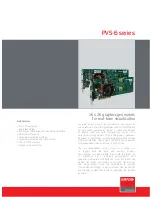
4
P
P
oints to note after installing the rear camer
oints to note after installing the rear camer
a
a
- Method of use -
••
Do not place too much reliance on the back-eye camera.
••
The backeye camera is meant to be used as a supplementary aid to help in avoiding obstructions.
••
If the lens is obscured by raindrops or similar, it may reduce in the effectiveness of the camera.
••
The position of the images displayed on the screen will vary depending on the vehicle conditions (such as
number of passengers and laden weight). Be sure to check for safety behind and around the vehicle while
driving.
••
Never reverse the vehicle while watching only the images produced by the camera.
Be sure to use the interior mirror and door mirrors also to check for safety behind and around the vehicle.
••
The characteristics of the camera lens will make all obstructions on the screen appear differently from their
actual positions and distances.
- Handling -
••
Do not subject the camera to strong shocks by hitting it firmly or knocking it against other objects.
If this is not observed, it may damage the camera or cause problems with operation.
••
Do not subject the camera lens to naked flames or sudden changes in temperature (example, "hair dryer") or
hot water, otherwise it may damage the camera or cause problems with operation.
••
Avoid using in direct sunlight for long periods of time. If this is not observed, burn-in of images may occur.
••
The initial image that is displayed from the rear of the vehicle will be a white image (it may vary depending
on the model of camera connected), but the image will gradually stabilize.
••
If the camera is used for long periods of time, the increase in temperature may cause white marks or
horizontal lines to appear. This is a characteristic of the CCD and is normal.
••
Flickering may occur in the images if the camera is used underneath fluorescent light in 50 Hz power supply
areas. This is normal and is not the sign of a malfunction.
••
Do not clean the backeye camera unit and lens, the bracket, or the camera cable with volatile chemicals
such as alcohol, kerosene, thinner or gasoline. Using such chemicals may cause warping, discoloration or
other damage.
••
Do not use cleaning substances that contain abrasive powders. Using such substances will damage the
camera.
••
If the lens area becomes dirty, wipe it gently with a soft cloth moistened with water. If the lens is rubbed
firmly with a dry cloth, it may scratch the lens.
••
Do not damage the camera cable. Water vapor or water may get inside the camera through the damaged
section and cause problems with operation, fire, or electric shocks.
••
If washing the vehicle with the backeye camera installed, do not apply water directly to the cabling to avoid
water getting inside the vehicle compartment.
••
Do not wash the backeye camera unit using automatic vehicle washing equipment or high-pressure washing
equipment. If such equipment is used, the camera may fall off or water may remain inside the camera. This
could result in problems with operation, fire, or electric shocks.
••
Periodically inspect the camera and the bracket. Check that the mounting screws are not loose and that the
adhesive areas are not peeling away. If the mounting screws are loose, they should be tightened. If this is
not done, the camera may come off and fall down, or pedestrians may touch it resulting in problems with
operation.
••
If sunlight shines directly into the camera or other strong light (such as sunlight reflected from the bumper or
headlights) shines into the camera, it may cause vertical lines (smearing) to appear at the top and bottom of
the light source. This is normal and is not the sign of a problem.
3-28510 BEC105 A5版(英語) 05.8.23 6:46 PM ページ4






























